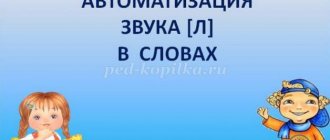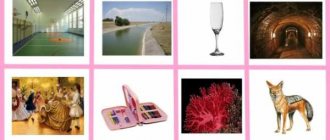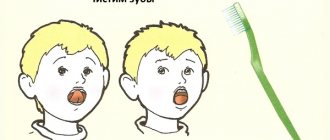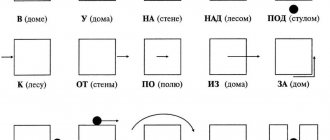Using games and play exercises to automate difficult to pronounce sounds
Automation of sound is the consolidation of the correct movements of the articulatory apparatus to pronounce a particular sound. In order to automate a sound, you must first learn to pronounce it in isolation, that is, separately from other sounds. The isolated sound delivered is very fragile, since the child who pronounces this or that sound incorrectly has developed the habit of defective pronunciation. By automating the sound in speech, you get rid of a negative stereotype and reinforce a new correct one. As you know, pronunciation is first fixed in isolation, then in syllables, words, phrases. In case of severe speech disorders (usually in various forms of dysarthria), the stage of automation is delayed; for a long time the child is unable to correctly pronounce the given sound in syllables and words, not to mention phrases. Repeated repetition of the same speech material quickly bores the child, tires him and makes him unwilling to study.
In my work, I use reminder diagrams for each sound I set:
1. Tongue position
Position of the tongue for the sounds S-S', Z-Z', C
Position of the tongue for the sounds SH-Zh, Shch, Ch, L-L', R-R'
2. Scheme for the correct pronunciation of all sounds.
| A | I | I open my mouth |
| ABOUT | Yo | lip wheel |
| U | YU | I pull my lips into a tube |
| Y | AND | mouth to ears, even sew on strings |
| E | E | mouth to ears, at least the strings are sewn + the jaw goes down |
In my practice, I use the following exercise options: “Kick the ball into the goal . Used to automate the sounds S-S', Z-Z', Ш, Ж, Р, Р'
Simple sound reproduction task. Tongue Twisters. Pure tongues are widely used by speech therapists to automate the sounds; they help to pronounce difficult-to-pronounce poems and phrases correctly and clearly.
“Remember - repeat” : Bark-mountain-nora Hurray-it’s time-game Headlight-para-guitar Yura-Ira-Vera game-kennel-kids plywood-panther-office
Repeat the phrases : Thin bark. There is a hole near the fence. Short pencil. Fragrant pie. Wide threshold. The kids are coming. Smooth road. Hometown. Pink Panther. Old trough. Old barn. Sharp axes. Expensive gift. Hoodie. Ruddy loaf.
“One - many” Mountain-mountains Burrow-holes Hole holes Par-pairs Mosquito-mosquitoes Bazaar-bazaars Headlights pattern-patterns fly agaric-fly agarics ax-axes ball-balls blow-blows set-sets motors-motors
Learn the tongue twister : Tarara-tarara - get up, kids! Tarara-tarara - it's time to go to kindergarten! Tururu-tururu – raising the children. Tyryry-tyryry - there are no children at home.
"Correct Dunno" . The speech therapist suggests distorted pronunciation of words and sentences. By throwing the ball, the speech therapist corrects the speech therapist. For example: I try to pronounce sounds in a melting manner. Etc.
"Say the word"
Tasks requiring mental and verbal activity
Name the words where this sound is hidden at the beginning, at the end, in the middle of the word.
Divide the words into syllables, choose a diagram for each word
Find the extra item
D/game “I know 5 objects” Automation of sounds R-L
I know 5 animate objects with the sound R (radio operator, tractor driver, Roma, tiger, lion cub) I know 5 inanimate objects with the sound R (rocket, radio, rose, crown, varnish)
Differentiation TR,DR,KR,PR, R-L
Repeat after me
Write a story using the names of geometric shapes.
Andrey and I decided to build a from geometric figures . We needed the following shapes: triangle , square , rectangle , line , circle . It took a lot of work . brother Andrei , Pyotr , sister Aleksandr and a neighbor from the third for help . Oh, hard work, but we it !!!!!! We hard !
Not all children need to practice sound in texts - if the child uses the new sound freely without tension, you can immediately move on to “free speaking.” Other children need automation in stories. For this purpose, short stories are selected, rich in sound being practiced. So how do you work with stories? It is necessary to pay attention to the fact that the material is selected from the simplest option to the complex option. When working with stories, both the adult and the child use sound without lengthening it, without increased pronunciation. The sound must be “equal” among other sounds.
Exercise “Say the Word.”
Exercise “Make friends with words.” Look, the evil Kikimora mixed up the words in the sentences! Help the words return to their places: “make friends” with them and pronounce the sentences correctly. Sample: Roma, axe, firewood, chop. — Roma chops wood with an axe.
On, yacht, sail, beautiful. Roma, axe, firewood, chop.
Dad, give roses, mom. Market, to, sell, fruit. Mom, give balls, Rodion. Paradise, basket, boletus, collect, c. House, lifting, build, crane, new.
Exercise “Correct the sentence.” The buffoon decided to make you laugh and came up with these sentences. Listen to them. Find and correct errors.
Gardens grow in roses. Roma cleans up the trash. Artyom bought a watermelon. Chickens feed Marusya. The fish caught the fisherman.
Yegor put on a red scarf. I gave the cake to Raya for his birthday. Vegetable gardens grow in tomatoes and cucumbers.
Exercise “Words tell numbers.” Help me unravel an incomprehensible story. Listen to him carefully. If you hear the name of a number, find the picture next to this number and name it.
On her day off, Raya and her parents went on an excursion to There she saw different animals: Her parents told her that all these animals live in hot countries. Striped had the longest neck, very similar to a horse. And the cubs of the huge carnivore played with each other like kittens. Raya really liked it
Stories of different types are presented:
1. Stories with pictures - a transition from words and phrases to retelling texts. They are short, and the sound most often occurs in only one word, which the child must insert in the right place in the sentence after presenting the picture.
2. Stories-tasks. In this case, too, the initial work is carried out with one or two words. The adult reads the problem, the child is interested in counting and giving the answer - first in one word, then in a full sentence. If successful, the child will happily retell this problem to another person. Make sure that the sound is pronounced correctly in the retelling.
Once the guys caught a lot of crayfish under the driftwood in the pond. “You and I,” he says, “will each have 4 crayfish, and we will give Uncle Roma 5 crayfish.” How many crayfish did Vera and Yura catch in total?
3. Stories with questions are the most wonderful part of the work. The fact is that an unprepared child will not be able to immediately retell the text, even without paying attention to the sounds, he simply will not remember the information. Questions are used to help the child in the retelling process. Our actions: we read the entire story, read the first sentence and ask the questions below, after reading to the end, we invite the child to retell the entire story. As usual, don’t forget about pronunciation. (First, read the whole story. Then we read the sentences one by one, after each we ask questions. At the end, the child retells the story.)
Yura and Ira have a new game. This is a radio. Who…? What…? “I’ll be the announcer,” says Yura. Who…? What does he say...? - This is a microphone. The city of Kovrov speaks. I pass the microphone to another announcer. “Today is a holiday in our city,” says Ira, Who...? What does he say...? — There will be different games and attractions. What will happen…?
4. Ordinary stories , rich in practiced sound. You may also need to ask questions here.
The boy is the opposite. For Yura Ryabinin it’s the other way around. The guys are drawing - Yura is playing games. The guys are preparing their homework - Yura is drawing, the guys are building a house - Yura is jumping. “Guys, let’s give Yura poems by Agnia Barto about a boy in reverse,” says Raya. Yura opens the book and sees the following lines, underlined in red pencil:
5. Compiling a story on a given topic. We offer the child a topic for discussion and words with practiced sounds that the child can use in his story.
If you were a chef in a restaurant, what would you prepare for dinner for first, second and third? Tell us about how you would cook and what. You can tell about this better if you remember how your mother prepares dinner.
At the zoo, the caretaker forgot to close the cages. And one animal ran out of it. Tell us how you would catch this animal if it were a tiger, bison, or zebra.
6. Read the text and retell it.
FIRST CONCERT
Makar was at the conservatory for the first time. His mother and sister came to the concert with him. Makar sat down in a beautiful red chair and looked at the stage. There were large musical instruments there: a drum, a harp, a piano. Soon the orchestra members came out to the audience and brought smaller instruments with them. These were violins, trombones, English horns. The last one to enter the stage was a man in a black tailcoat and turned his back to the audience. He looked at the orchestra members and suddenly began waving his arms. Makar turned to his sister and whispered: “Uncle is angry. He didn’t get the instrument.”
Material for automation of sounds Р, Рь
References used: 1. Arkhipova E.F. Making sounds for dyslalia. 2. Samorokova O.P. Kruglikova T.N. We distinguish sonorous sounds 3. Epifanova O.V. Consonants and vowels are similar, but different. V., 2006. 4. Epifanova O.V. Automation of the sound “L”. V., 2006. 5. Kovshikov V.A. Correction of violations of sound discrimination. St. Petersburg, 2006 6. Zhukova N.S. Speech therapist lessons. Correction of speech disorders. M., 2013. 7. Flerova Zh.M. Speech therapy. Rostov-on-Don., 2000. 8. Pozhilenko E.A. A magical world of sounds and words. M., 2001. 9. Svetlova I.E. Home speech therapist. M., 2002. 10. Reznichenko T.S. We speak correctly. M., 2002. 11. Speech therapy notebook for the sounds R, Rb.
Golder Alina Vasilievna teacher-speech therapist MBOU Secondary School No. 6 Noyabrsk, Yamalo-Nenets Autonomous Okrug
“What subject did you miss?”
Goal: Automation of the sound L in words. Practice agreeing nouns and adjectives in gender and number, using the genitive case singular and plural of nouns and adjectives. Develop attention, memory, thinking.
Description: Name the object and color in the first row (white dove, white towel, white lilies of the valley). Say it again and remember. Name the objects in the second row (white towel, white lilies of the valley). What item is missing? (there is no white dove) Name the objects in the third row (white dove, white lilies of the valley). What item is missing? (no white towel) Name the objects in the fourth row (white dove, white towel). What item is missing? (no white lilies of the valley)
Vacancies from verified employers in a convenient area.
Game "4th wheel"
Goal: Automate the sound L in words. To develop the ability to classify objects and use generalization words in speech. Develop memory and thinking. Description: Name objects, clearly pronouncing the sound L in words (apple, beets, onions, eggplant). Determine which item is redundant. Explain why. (An extra apple because beets, onions and eggplant are vegetables, and an apple is a fruit)
Name objects, clearly pronouncing the sound L in words (glass, spoon, table, plate). Determine which item is redundant. Explain why. (An extra table, because a glass, spoon, plate are dishes, and a table is furniture)
Name objects, clearly pronouncing the sound L in words (spinning top, clown, doll, horse). Determine which item is redundant. Explain why. (An extra horse, because a spinning top, a clown, a doll are toys, and a horse is an animal)
Name objects, clearly pronouncing the sound L in words (woodpecker, elk, squirrel, horse). Determine which item is redundant. Explain why. (An extra woodpecker, because an elk, a squirrel, a horse are animals, and a woodpecker is a bird)








